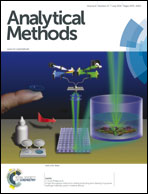Glutathione-capped CdTe quantum dots for the determination of fleroxacin with dual-wavelength fluorescence signals
Abstract
A sensitive and simple method for the determination of fleroxacin (FLO) was developed based on the changes of dual-wavelength fluorescence signals of glutathione (GSH)-capped CdTe quantum dots (QDs). Under optimum conditions, a linear calibration plot of the quenched fluorescence intensity at 555 nm against the concentration of FLO was observed in the range of 0.0262–35.0 μg mL−1 with a correlation coefficient (R) of 0.9992. Meanwhile, a linear calibration plot of the enhanced fluorescence intensity at 429 nm against the concentration of FLO was observed in the range of 0.1966–35.0 μg mL−1 with a correlation coefficient (R) of 0.9986. The corresponding detection limits (3σ/K) are 17.93 ng mL−1 at 555 nm and 59.58 ng mL−1 at 429 nm. In addition, a detailed reaction mechanism has also been proposed on the basis of electron transfer supported by ultraviolet-visible (UV-vis) absorption, fluorescence (FL) spectroscopy and the measurement of fluorescence lifetime. The method has been applied for the determination of FLO in pharmaceutical preparations with satisfactory results. The proposed method manifested several advantages such as high sensitivity, short analysis time, low cost and ease of operation.


 Please wait while we load your content...
Please wait while we load your content...